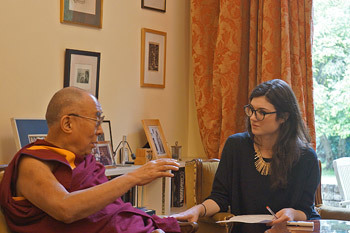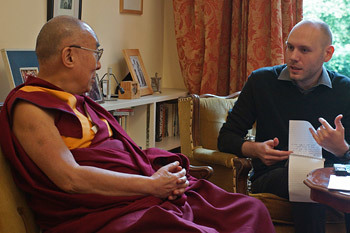London, England, 18 September 2015 - Before leaving Cambridge today, His Holiness the Dalai Lama gave a couple of interviews to the press. Fiona Wilson of The Times talked to him about ‘What I have Learned’, some of her questions being personal, others topical. When she asked what he thinks of the situation of refugees in Europe, he replied:

|
Fiona Wilson of the Times interviewing His Holiness the Dalai Lama in Cambridge, UK on September 18, 2015.
Photo/Jeremy Russell/OHHDL
|
“It’s wonderful that several countries will be taking refugees in, but in the long run we have to find a peaceful solution to the conflicts in the countries they come from. We must make an effort to bring about peace.”
When she asked if violence is ever justified in the name of religion, he replied: “Never.”
And as to whether war is ever justified, he said: “It’s difficult to say. The Second World War defeat of Nazism was beneficial and the Korean War saved South Korea, but it would be hard to say the same about the Vietnam War.”
Questioned about his earliest memory and His Holiness said he clearly remembers when he was about two how powerful was his mother’s affection.
Responding to whether secularization dilutes the power of religious teachings he told her he believes that if the Buddha were to appear today, he would teach secular ethics. When asked which religious leaders he admires he mentioned Pope John Paul II for his work to promote inter-religious harmony.
Ms Wilson asked, “Do you ever get angry?” and he told her: “Yes, sometimes when my staff makes mistakes, but it only lasts a moment.”
To the enquiry, “When are you happiest?” he replied: “Every day I make a prayer to dedicate myself to the service of others.”

|
Steven MacKenzie of Big Issue interviewing His Holiness the Dalai Lama in Cambridge, UK on September 18, 2015. Photo/Jeremy Russell/OHHDL
|
Steven MacKenzie of The Big Issue, a magazine published on behalf of and sold by homeless or vulnerably housed people, referred to His Holiness as the world’s most famous refugee. He asked if he still feels displaced, to which His Holiness said:
“We Tibetans have a saying: ‘Wherever you are happy is home, Whoever is kind to you is like your parents.’”
MacKenzie also wanted to know about communications with the people in Tibet. His Holiness told him that between the time when he escaped and 1979 very few Tibetans were able to leave Tibet, but as a result of Deng Xiaoping’s reforms in 1979-80 some were able to come and go.
His Holiness next met with members of a group who call themselves NKT Survivors, people who have left the new religious movement the New Kadampa Tradition. One of several reasons for their discomfort has been the involvement of NKT members in spiteful demonstrations against His Holiness the Dalai Lama in cities across the world. The focus of these protests is a difference of opinion about a controversial spirit known as Dolgyal or Shugden. His Holiness began:
“I think you know the story of this spirit is nearly four hundred years old. At one time I too propitiated it. My Senior Tutor, Ling Rinpoche, who gave me ordination, had nothing to do with it, but my Junior Tutor, Trijang Rinpoche did practise it. Having some doubt about it, in the early 70s I asked some scholars to research the matter. We discovered that the issue dated back to the time of the 5th Dalai Lama, who described Dolgyal as a perfidious spirit that had arisen as a result of distorted prayers.
“Later, during the time of the tutor of the 7th Dalai Lama, Ngawang Chokden, who also became Ganden Tripa, Throne-holder or leader of the Gelug tradition, several abbots propitiated this spirit and a shrine was built at Ganden Monastery. Ngawang Chokden, who was the first Reting Rinpoche, had this shrine demolished and restricted the propitiation. He stated that during the life of Je Tsongkhapa, the founder of the Gelug tradition, a shrine even to his ‘birth deity’ was not allowed within the precincts of Ganden Monastery.

|
His Holiness the Dalai Lama with NKT Survivors during their meeting in Cambridge, UK on September 18, 2015. Photo/Jeremy Russell/OHHDL
|
“Later still, the 13th Dalai Lama restricted practices concerning this spirit and wrote to Pabongka Rinpoche about it, saying that the way he related to it risked breaching his Buddhist refuge vows. I discovered that no Dalai Lama had any involvement with this spirit until I did. Perhaps if the 5th and 13th Dalai Lamas were to reappear now they’d send me back to Amdo!
“Once I made a decision to stop the practice, I kept it to myself. Then Ganden Jangtse Monastery got in touch with me to say that they had been experiencing misfortunes and they had asked Trijang Rinpoche about it. He told them it was a result of displeasure on the part of their traditional protector Palden Lhamo. They asked me what to do about it. I conducted a ‘dough-ball divination’ asking first whether their problems were to do with Palden Lhamo’s displeasure. The answer was, “Yes”. Then I asked whether the displeasure was a result of their adopting a new protector and again the answer was “Yes”. I informed some senior Lamas from Ganden Monastery and asked them to decide what action to take.
“Gradually this advice became known. Inside Tibet some worshippers of Dolgyal said that the Dalai Lama was taking these steps because he was trying to favour the Nyingmas, so I had to explain things more publicly. Previously, even my Senior Tutor, Ling Rinpoche, who had nothing at all to do with this practice had been wary of my receiving Nyingma teachings because of Dolgyal’s reputation. Once I stopped propitiating it I gained personal religious freedom and was able to follow an ecumenical, non-sectarian approach to Buddhism like previous Dalai Lamas. I had confirmed this course of action through another divination before a renowned statue of Avalokiteshvara.
“As a consequence of all this, supporters of Dolgyal set themselves up as a group in Delhi. Then the murder of Gyen Lobsang Gyatso took place. The perpetrators, who had been identified by the Himachal Pradesh Police in their investigation, escaped back to Tibet, where they were welcomed by Chinese officials.
“When I explain about all this, I make clear that it’s my duty to do so. If people disagree and continue the practice, that’s their business. However, I’m concerned about their next lives. These demonstrators are angry with me. I try to cultivate the awakening mind of bodhichitta and an understanding of emptiness, being angry with me won’t do them any good. When I see them, I feel a lot of concern for them.
“As Buddhists we should follow authentic teachings, such as those of the 17 Nalanda masters. Depending on spirits like this is a degeneration of the practice of the Dharma.
“Because of tantric tradition we tend to emphasise ‘Guru Yoga’ and following the Guru’s word. However, even the Buddha advised his followers to examine what he said, to investigate whether it made sense, rather than accepting it just at face value. Read more widely. Study the works of Nagarjuna, Chandrakirti and Shantideva. Also read Je Tsongkhapa’s ‘Great Stages of the Path to Enlightenment’. Don’t worry about having made mistakes, the 14th Dalai Lama did too.
“Kelsang Gyatso’s commentary to Shantideva’s ‘Guide to the Bodhisattva’s Way of Life’ is good. Still, pay attention to the four reliances: depend not on the person, but on the teaching. Depend not on the words, but their meaning. Depend not on the provisional meaning, but the definitive meaning and finally depend not on a superficial understanding but on wisdom. Read books, gather your friends together and discuss what you’ve learned. Give each other confidence. I admire your courage. Believe in truth and the Buddha’s authentic teachings.
“I know Kelsang Gyatso. He was not a Geshe, but a good scholar. When I was in Mussoorie he gave me a copy of Gungthang Rinpoche’s writings for which I was grateful to him. Lama Zopa invited him to teach in England, but later they quarrelled. I sent an official to try to mediate. In 1981, he came to Deer Park in Madison Wisconsin to receive the Kalachakra empowerment that I was giving at the request of his teacher Geshe Sopa. So although he has now taken against me, his own teacher, apparently he insists that his own students only follow him. You should continue to regard him with respect, even if you tell yourself that you are now trying to follow the authentic teachings of the Buddha and Je Tsongkhapa.”
His Holiness told the group to feel happy and that he would remember them. He again told them not to worry if they feel they had made a mistake, they can remind themselves that he did too.
|
His Holiness the Dalai Lama watching school children performing during his visit to Newton Preparatory School in London, UK on September 18, 2015. Photo/Jeremy Russell/OHHDL
|
After lunch, His Holiness travelled to London to visit Newton Preparatory School, Battersea. Following the two days discussions in Cambridge, the Inspire Dialogue Foundation had arranged for a meeting with school-children, the generation of the 21st century. He was accompanied by Lord Williams and they were met at the door by headmistress Alison Fleming. She escorted them through the school, the way lined by singing children, to the auditorium.
For a joyful hour, children from seven different groups across London presented performances they had created themselves related to human rights, freedom and how they envisage the world they want to grow up in. Some danced, some sang, some recited poems, others performed drama and shadow play. At the end of each group's performance they sat at His Holiness’s and Lord Williams’s feet and talked and asked each other questions.
At the end of the afternoon, after words of thanks from Alison Fleming, Cameron Taylor and Lord Rumi Verjee, His Holiness pointed to a sign on the wall with the word peace on it. He said:
“That word peace - peace is our goal. And peace must come about through inner peace. If the world is at peace it’s good for us all. If we live honestly and transparently trust will emerge and from trust develops friendship. Thank you for inviting me here.”



